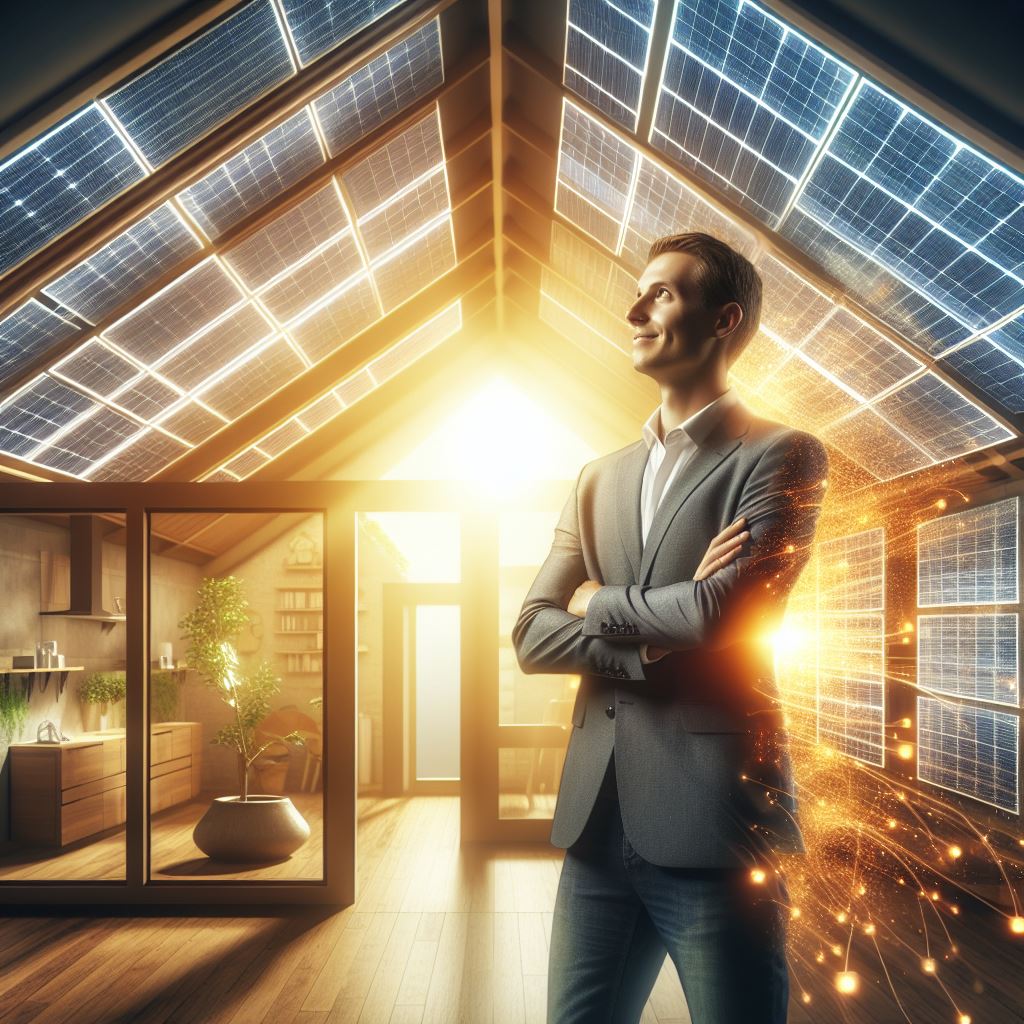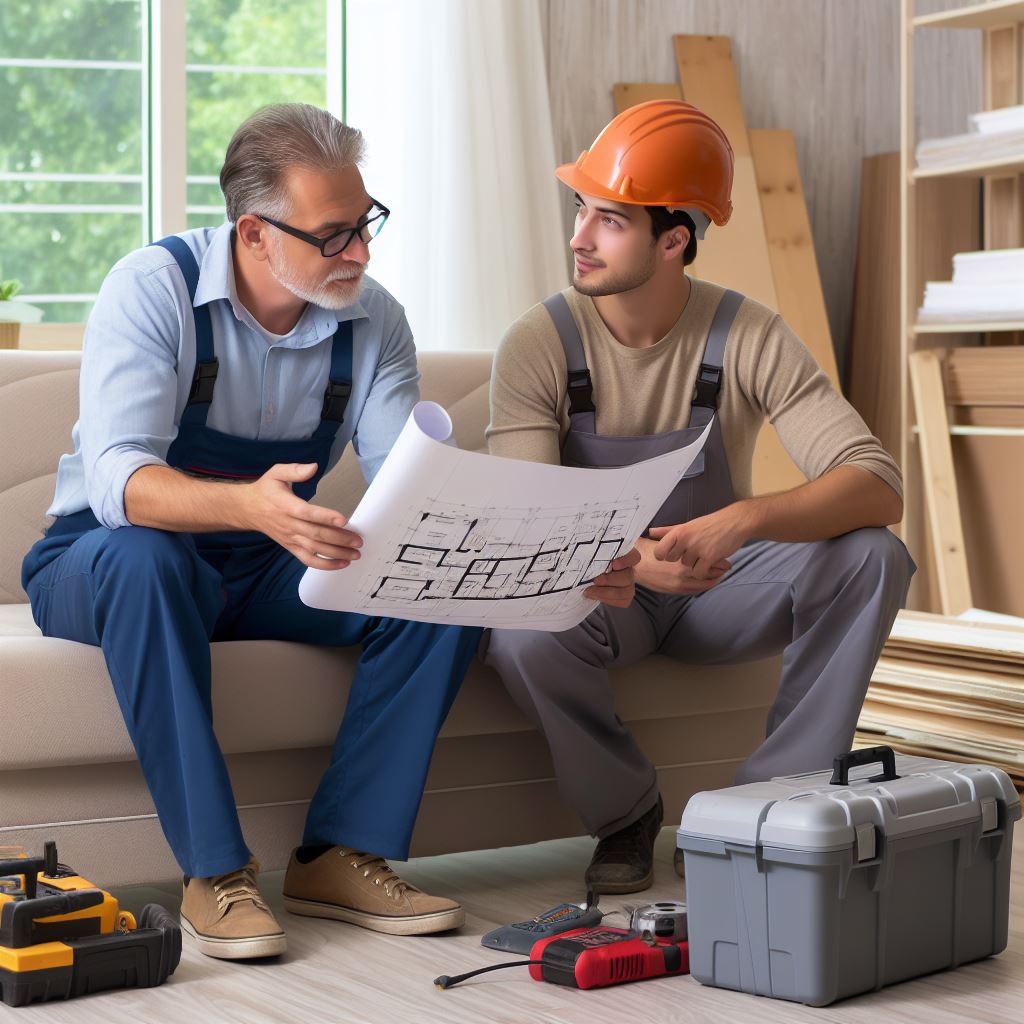Introduction
Eco-friendly technology in modern homes has become an increasingly significant topic in the real estate industry.
The growing importance of sustainability and eco-consciousness has sparked a demand for environmentally friendly features in homes.
With the threat of climate change and the depletion of natural resources looming, more people are recognizing the need to adopt sustainable practices in their daily lives.
As a result, the real estate industry has started incorporating eco-friendly technology into modern homes.
The focus on sustainability not only benefits the environment but also creates a healthier living space for homeowners.
Eco-friendly tech includes energy-efficient appliances, solar panels, smart home automation, and water-saving fixtures.
By embracing these technologies, homeowners can significantly reduce their carbon footprint and lower their energy bills.
Additionally, sustainable homes are designed to maximize natural light and ventilation, providing a healthier and more comfortable environment.
The real estate industry has acknowledged the increasing demand for eco-friendly homes, with many developers now incorporating sustainable features in their projects.
Builders are using recycled and locally sourced materials, installing energy-efficient HVAC systems, and integrating renewable energy sources.
Moreover, eco-friendly homes often increase their resale value, attracting environmentally conscious buyers.
As sustainability continues to shape the real estate industry, it is becoming clear that eco-friendly technology is no longer just a trend but a necessity for modern homes.
In essence, the growing importance of sustainability and eco-consciousness has led to the incorporation of eco-friendly technology in modern homes.
These advancements benefit both the environment and homeowners, creating a healthier and more sustainable living environment.
Benefits of Eco-Friendly Tech
When it comes to modern homes, incorporating eco-friendly technology brings about numerous advantages.
Transform Your Real Estate Decisions
Unlock personalized real estate insights crafted just for you. Get actionable advice designed to amplify your success.
Get StartedFrom energy efficiency to cost savings and environmental preservation, the positive impact is undeniable.
Additionally, it has the potential to increase home value and market appeal.
Energy Efficiency
- Eco-friendly tech reduces energy consumption, resulting in lower utility bills.
- Innovative systems like smart thermostats optimize energy usage and reduce wastage.
- Efficient appliances and LED lighting use less electricity without compromising performance.
- Solar panels and wind turbines generate clean and renewable energy for homes.
Cost Savings
- Lower energy bills translate to significant long-term cost savings for homeowners.
- Government incentives and tax credits are often available for utilizing eco-friendly technologies.
- Homeowners can reduce water bills by installing water-saving fixtures and rainwater harvesting systems.
- Energy-efficient appliances have longer lifespans, reducing replacement and maintenance costs.
Environmental Preservation
- Eco-friendly tech reduces carbon footprint, mitigating the impact of climate change.
- Green building materials minimize the use of harmful substances and promote sustainable construction.
- Water conservation systems help preserve this valuable resource for future generations.
- Reduced reliance on fossil fuels reduces air and water pollution, benefiting the environment.
Increased Home Value and Market Appeal
- Homes equipped with eco-friendly technology tend to have higher resale value.
- Buyers are increasingly attracted to energy-efficient homes, leading to a larger market appeal.
- Green certifications like LEED or Energy Star enhance a home’s reputation and desirability.
- Eco-friendly features differentiate a property and can expedite the selling process.
In fact, incorporating eco-friendly tech in modern homes brings a multitude of benefits. Energy efficiency leads to cost savings and reduces environmental impact.
Moreover, the potential for increased home value and market appeal makes it a wise investment.
By embracing eco-friendly technology, homeowners not only improve their living spaces but also contribute to a more sustainable future.
Read: Tech Districts: Real Estate Gold?
Smart Home Automation
The concept of smart home automation and its role in eco-friendly tech
The concept of smart home automation plays a crucial role in eco-friendly tech.
It allows homeowners to control and monitor various devices and systems to optimize energy consumption and reduce environmental impact.
How smart devices and systems can monitor and control energy consumption
Smart devices and systems are designed to monitor and control energy consumption in a sustainable manner.
These devices can collect data on energy usage, analyze patterns, and make necessary adjustments to optimize efficiency.
Examples of smart home automation technologies
Thermostats
Thermostats are a prime example of smart home automation technology.
These devices can learn from homeowner preferences and adjust the temperature accordingly.
They can also be remotely controlled through smartphone apps, allowing users to manage energy consumption even when not at home.
Lighting controls
Lighting controls are another smart home automation feature that promotes energy efficiency.
Showcase Your Real Estate Business
Publish your company profile on our blog for just $200. Gain instant exposure and connect with a dedicated audience of real estate professionals and enthusiasts.
Publish Your ProfileThese systems utilize sensors and timers to automatically turn off lights when no one is in the room and adjust brightness levels based on natural lighting conditions.
This helps to reduce energy wastage and lower electricity bills.
Energy management systems
Energy management systems take smart home automation to the next level.
These systems integrate various devices and appliances, allowing homeowners to have centralized control over their energy consumption.
They can monitor energy usage in real-time, analyze historical data, and provide insights to help users make informed decisions about energy-saving practices.
In addition to controlling and monitoring energy consumption, smart home automation can also optimize other aspects of a home’s eco-friendliness.
For example, water conservation can be achieved through smart irrigation systems that adjust watering schedules based on weather conditions and soil moisture levels.
Furthermore, smart appliances such as refrigerators, washing machines, and dishwashers can be programmed to run during off-peak hours when electricity demand is lower, reducing strain on the grid and saving energy.
Overall, smart home automation is an essential component of eco-friendly tech in modern homes.
By enabling homeowners to monitor and control energy consumption, it promotes sustainability and reduces environmental impact.
Through the use of technologies like thermostats, lighting controls, and energy management systems, homes can become more energy-efficient and contribute to a greener future.
To sum up, smart home automation is revolutionizing the way we live in our homes.
With its ability to monitor and control energy consumption, it offers a significant contribution to eco-friendly tech.
By utilizing smart devices and systems, homeowners can optimize energy efficiency, reduce wastage, and lower their environmental footprint.
With technologies like thermostats, lighting controls, and energy management systems, the potential for a greener future is within our reach.
Read: Tech Innovations in Home Security
Renewable Energy Sources
The use of renewable energy sources in modern homes
The use of renewable energy sources in modern homes is becoming increasingly popular.
People are now realizing the importance of reducing their carbon footprint and the benefits of embracing eco-friendly living.
Two notable renewable energy sources that are widely adopted are solar panels and wind turbines
These technologies harness the power of the sun and wind to generate electricity, reducing our reliance on traditional fossil fuels.
How solar panels and wind turbines can contribute to eco-friendly living
Solar panels are perhaps the most well-known form of renewable energy.
They capture sunlight and convert it into usable electricity through the photovoltaic effect.
Installing solar panels on the roofs of homes allows homeowners to generate their own electricity and reduce their dependence on the grid.
This not only saves money on electricity bills but also helps to reduce greenhouse gas emissions.
In addition to solar panels, wind turbines are another popular option for generating renewable energy.
These tall structures with rotating blades convert the kinetic energy of the wind into electricity.
Wind farms are often seen in windy areas where multiple turbines work together to generate power.
Wind turbines are efficient and can generate a significant amount of electricity, providing a sustainable source of energy for modern homes.
Economic benefits and long-term savings associated with renewable energy
The use of renewable energy sources in modern homes offers numerous benefits.
Apart from reducing carbon emissions and contributing to a greener environment, there are economic advantages as well.
Showcase Your Real Estate Business
Publish your company profile on our blog for just $200. Gain instant exposure and connect with a dedicated audience of real estate professionals and enthusiasts.
Publish Your ProfileOne of the main benefits is the long-term savings associated with using renewable energy.
Though the initial installation cost of solar panels or wind turbines may seem high, the savings on electricity bills can quickly offset that investment.
Over time, homeowners can save substantial amounts of money by generating their own electricity.
Furthermore, the economic benefits extend to the community as a whole.
When more households embrace renewable energy, it reduces the strain on traditional power grids.
As a result, government and utility companies can save money on infrastructure development and maintenance, which can ultimately lead to lower electricity rates for everyone.
Moreover, the use of renewable energy in homes also creates job opportunities.
The renewable energy sector is growing rapidly, and more employment opportunities are being created in industries related to solar and wind power.
This not only benefits the economy but also helps in the transition to a more sustainable future.
In short, the use of renewable energy sources such as solar panels and wind turbines in modern homes is gaining momentum due to the multiple benefits they offer.
From reducing carbon emissions to saving money on electricity bills, renewable energy provides an environmentally friendly and economically viable solution.
Embracing eco-friendly living not only benefits individual homeowners but also contributes to a greener and more sustainable future for the planet.
Read: Real Estate Bubbles: Spotting Signs

Energy-Efficient Appliances
Importance of energy-efficient appliances in eco-friendly homes
In today’s world, where environmental concerns are at the forefront, eco-friendly homes are becoming increasingly popular.
One crucial aspect of these houses is the use of energy-efficient appliances, which play a significant role in reducing energy consumption and environmental impact.
Energy-efficient appliances are designed to operate using less energy while providing the same level of efficiency as their conventional counterparts.
These appliances are equipped with advanced technologies that reduce power consumption and minimize greenhouse gas emissions.
The importance of these eco-friendly appliances cannot be overstated.
Advancements in energy-saving technologies for various appliances
The advancements in energy-saving technologies have revolutionized the way appliances operate.
For instance, refrigerators now come with features such as improved insulation, advanced compressors, and smart sensors to optimize energy usage.
These advancements not only help in reducing energy consumption but also ensure better food preservation.
Similarly, dishwashers have undergone significant advancements to become more energy-efficient.
They now feature improved water and energy management systems, reducing both water and electricity usage.
Some models also include innovative features such as soil sensors and half-load options, further optimizing energy consumption.
Washing machines have also embraced energy-saving technologies.
Modern models come with features such as automatic load detection, which adjusts the water and energy usage according to the laundry load.
Additionally, the use of efficient motors and improved drum designs helps in reducing energy consumption and water wastage.
Examples of energy-efficient appliances like refrigerators, dishwashers, and washing machines
One notable example of an energy-efficient appliance is the ENERGY STAR certified refrigerator.
These refrigerators are designed to consume significantly less energy compared to traditional models.
They come with advanced insulation, high-efficiency compressors, and improved defrosting mechanisms, combining sustainability with functionality.
Showcase Your Real Estate Business
Publish your company profile on our blog for just $200. Gain instant exposure and connect with a dedicated audience of real estate professionals and enthusiasts.
Publish Your ProfileAnother energy-efficient appliance is the dishwasher with an ENERGY STAR rating.
These dishwashers use advanced water and energy management systems, consuming less water and electricity while ensuring sparkling clean dishes.
With features like soil sensors and half-load options, they offer convenience without compromising on energy efficiency.
The washing machine market also offers energy-efficient options, such as front-loading washers with the ENERGY STAR label.
These machines use less water and energy due to their design and advanced technologies like automatic load detection.
Additionally, they come with shorter wash cycles, saving both time and energy.
Investing in energy-efficient appliances not only benefits the environment but also homeowners.
While these appliances may have a higher upfront cost, the long-term savings in energy bills outweigh the initial investment.
Moreover, many governments and utility companies offer incentives and rebates for purchasing energy-efficient appliances, making them even more appealing.
In general, energy-efficient appliances are an essential component of eco-friendly homes.
The advancements in energy-saving technologies have transformed various appliances, including refrigerators, dishwashers, and washing machines.
By opting for these eco-friendly options, homeowners can reduce their energy consumption, lower utility bills, and contribute to a greener future.
Read: IoT Devices Transforming Home Life
Water Conservation Systems
Water is a precious resource that must be conserved in eco-friendly homes.
Without proper water conservation, we risk depleting our freshwater sources and harming the environment.
Fortunately, there are various technologies and systems available to reduce water consumption and promote sustainable living.
Low-Flow Fixtures
One effective way to conserve water is by installing low-flow fixtures in homes.
These fixtures, such as low-flow toilets and faucets, are designed to use less water without sacrificing performance.
By reducing the volume of water used during each flush or use, significant water savings can be achieved.
Rainwater Harvesting
Another innovative water-saving technology is rainwater harvesting. This system involves collecting rainwater from rooftops and storing it for later use.
The collected water can be used for various purposes, such as watering plants, flushing toilets, or even washing clothes.
Rainwater harvesting not only conserves water but also reduces the reliance on freshwater sources.
Greywater Recycling
Greywater refers to gently used water from sources like sinks, showers, and washing machines.
Instead of letting this water go down the drain, it can be recycled and reused for non-potable purposes.
Greywater recycling systems collect, filter, and treat the greywater, making it suitable for irrigation or toilet flushing.
By utilizing greywater, households can significantly reduce their freshwater consumption.
Smart Irrigation Systems
Outdoor water usage, particularly for irrigation, accounts for a substantial amount of water consumption.
To address this, smart irrigation systems have emerged.
These systems utilize advanced technology to optimize watering schedules based on weather conditions, soil moisture levels, and plant type.
By delivering water only when needed, smart irrigation systems eliminate unnecessary watering and minimize water waste.
Showcase Your Real Estate Business
Publish your company profile on our blog for just $200. Gain instant exposure and connect with a dedicated audience of real estate professionals and enthusiasts.
Publish Your ProfileLeak Detection and Monitoring
Undetected leaks can lead to significant water wastage over time. Therefore, implementing leak detection and monitoring systems is crucial.
These systems use sensors to detect leaks and provide real-time alerts to homeowners.
By promptly identifying and fixing leaks, water loss can be minimized, and conservation efforts can be enhanced.
Dual-Flush Toilets
Traditional toilets use a fixed amount of water for every flush, which is often more than necessary.
Dual-flush toilets provide a practical solution by offering two flush options – one for liquid waste and another for solid waste.
This flexibility allows users to use less water when appropriate, resulting in substantial water savings.
Water-Efficient Appliances
Beyond fixtures, many household appliances contribute to water consumption, such as dishwashers and washing machines.
Water-efficient appliances, like those with Energy Star ratings, are designed to use less water while maintaining optimum performance.
Choosing these appliances not only conserves water but also reduces energy consumption, benefiting both the environment and utility bills.
In summary, water conservation is a vital aspect of eco-friendly homes. Various technologies and systems are available to significantly reduce water consumption.
Examples include low-flow fixtures, rainwater harvesting, greywater recycling, smart irrigation systems, leak detection, dual-flush toilets, and water-efficient appliances.
By implementing these water-saving measures, homeowners can play their part in protecting our valuable freshwater resources and creating a sustainable future.
Let’s embrace these eco-friendly technologies and make a positive impact on our planet.
Building Materials and Construction Techniques
When it comes to designing and constructing eco-friendly homes, the choice of building materials and construction techniques plays a crucial role.
By opting for sustainable options, we can minimize the environmental impact and create homes that are not only durable but also contribute to a healthier planet.
Sustainable Building Materials
The use of sustainable building materials is on the rise as more homeowners and builders become aware of the benefits they offer.
These materials are sourced in a responsible manner, ensuring that natural resources are not depleted and ecosystems are not harmed.
By using sustainable materials, we can reduce carbon emissions and save energy during production.
Materials like reclaimed wood, recycled steel, and bamboo are excellent examples of sustainable options that can be utilized in modern home construction.
Not only do they have low environmental impact, but they also promote the conservation of natural resources.
Importance of Low Environmental Impact
Making use of materials with low environmental impact is vital in eco-friendly home construction.
Traditional materials like concrete and steel contribute significantly to greenhouse gas emissions and are not sustainable in the long run.
On the other hand, low impact materials such as rammed earth, adobe, and hempcrete have a much smaller carbon footprint.
These materials can be locally sourced, reducing transportation costs and energy consumption.
Incorporating them into construction can help achieve a more sustainable and greener future.
High Durability for Long-Term Sustainability
While environmental impact is a significant consideration, longevity and durability are equally important in building eco-friendly homes.
Choosing materials that are long-lasting ensures that the construction will stand the test of time and reduce the need for frequent repairs or replacements.
Materials like cedar, bamboo, and metal roofing offer high durability and can withstand harsh weather conditions.
Investing in such materials translates to reduced maintenance costs, minimized waste generation, and increased overall sustainability of the structure.
Eco-Friendly Alternatives to Traditional Building Materials
In addition to sustainable options, there are numerous eco-friendly alternatives to traditional building materials that can be used in modern homes.
Showcase Your Real Estate Business
Publish your company profile on our blog for just $200. Gain instant exposure and connect with a dedicated audience of real estate professionals and enthusiasts.
Publish Your ProfileThese alternatives not only reduce the environmental impact but also provide better insulation, improved energy efficiency, and increased comfort for residents.
Bamboo, for instance, is an excellent substitute for hardwood as it grows rapidly and is highly renewable.
Recycled wood is another alternative that reduces the demand for virgin timber while utilizing materials that would otherwise go to waste.
Green roofs, made with vegetation and soil, help regulate indoor temperature and absorb rainwater, reducing the strain on drainage systems.
In a nutshell, the choice of building materials and construction techniques greatly influences the eco-friendliness of modern homes.
By opting for sustainable materials with low environmental impact and high durability, we can create structures that are not only aesthetically pleasing but also contribute positively to the environment.
It is time to embrace these eco-friendly alternatives and work towards a greener future.
Conclusion
Incorporating eco-friendly tech in modern homes offers numerous benefits and holds significant importance.
Embracing sustainable practices can lead to a healthier environment, reduced energy consumption, and cost savings.
Individuals and the real estate industry should take proactive steps to adopt eco-friendly technology and create greener living spaces.
This will not only benefit the current generation but also play a crucial role in preserving the environment for future generations.
To further delve into the subject, individuals can explore various resources available.
They can visit websites like www.greenbuilding.com and www.energystar.gov to gather more information on eco-friendly technology and its implementation in homes.
Additionally, consulting with experts, attending sustainability workshops, and reading books on the topic can provide valuable insights and guidance.
By embracing eco-friendly tech, we can create a sustainable future where modern homes are designed to minimize their impact on the environment, promote energy efficiency, and create healthy living spaces for everyone.




